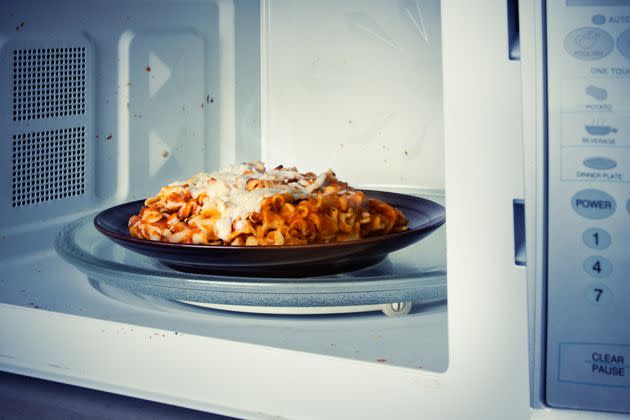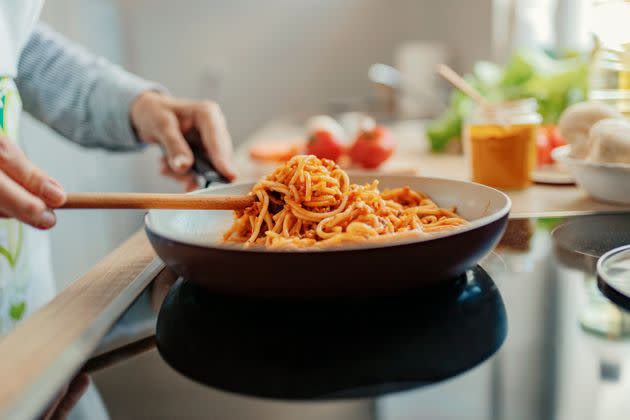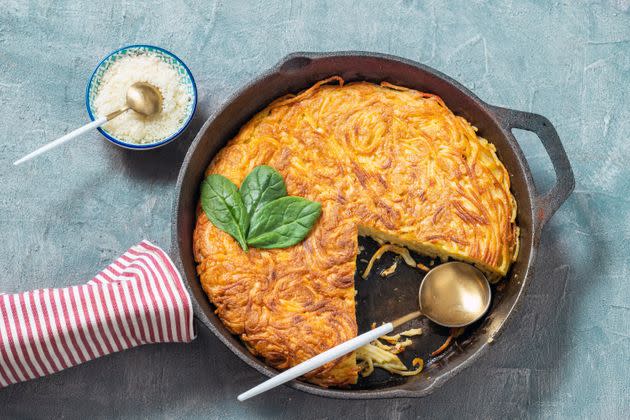How To Reheat Leftover Pasta Without Murdering Its Soul

The microwave is never your best option, but there's a trick to make it a work a little better. (Photo: Spauln via Getty Images)
For home cooks who are budget-conscious, eco-conscious or generally interested in streamlining their weekly meal prep, leftovers can play a crucial role in their money-saving, waste-reducing and time-crunching endeavors.
However, the key to maximizing your leftovers’ potential is coming up with a plan that highlights the dish’s positive attributes while also mitigating its downsides. Leftover pasta serves as a prime example of this principle; from a textural standpoint, reheated pasta can run into any number of challenges. If you’ve ever wondered why pasta often comes out mushy or dry when reheated, and if you’ve ever wondered what you can do to avoid that sad fate, we have some answers for you, courtesy of food scientists and professional chefs.
Why does reheated pasta turn so gummy?
When we asked food scientist and consultant Brian Chau why refrigerated pasta has a tendency to become gummy (and why those negative characteristics only heighten during the reheating process), he gave us a direct answer: “Starch. The cooking process of pasta draws out the starches when boiled. The starches, when cooled, go through [a process called] starch retrogradation. What that means is that the cooked starches have gelatinized and are forming a gel-like structure that will solidify when cooled down.”
Chau gets more granular with his explanation by telling us that “the amylose and amylopectin in the starch molecules are creating [that] gel-like structure. The sticky, gummy texture [causes the pasta to] congeal, which means the strands or pieces of pasta will stick to each other.”
Cooked and refrigerated pasta can also progress beyond the “gummy” stage and become downright mushy. Chau explained this by saying that “mushiness is due to the presence of too much water around the pasta.”
“When the starch retrogrades but is exposed to a pool of water at the bottom of the container, the starches interact with the water and form a mushy texture, much like how starch dissolves in water,” he added.
Cooking pasta to-order and tossing it with reheated sauce will yield the best results.
Cooked pasta can be a tricky leftover dish, but pasta sauce ― from meat sauce to cream sauce to marinara to pesto ― generally keeps very well in the fridge and freezer. For that reason, the best and most foolproof way to use leftover pasta is to “make extra sauce and then cook a fresh batch of pasta to go with the leftover sauce,” explained Nico Romo, the chef and owner of Laura in Summerville, South Carolina. Chef and cookbook author Amy Riolo also prefers this method, pointing out that “in Italy, the sauces are usually reheated on the stove, but pasta is cooked fresh each day.”

Part of the key is avoiding leftover pasta in the first place, cooking only the amount you need. (Photo: PixelsEffect via Getty Images)
Sautéeing in a skillet works best for sauced pasta.
Let’s say that you cooked a full pound of pasta for dinner, tossed it with your sauce of choice, served it up to your family, friends, roommates or even just yourself, and then ended up with a supply of cooked and sauced leftovers. According to Fernando Scarpati, the executive chef of Ferdi in New York City, this pasta should be “dry sautéed.”
“This means that you heat up a stainless steel skillet, pour a teaspoon of [olive] oil into the hot skillet, add the pasta to be reheated, and constantly toss the pasta, ‘sautéeing’ it for three or four minutes,” he explained. “It will be hot, still firm, and not mushy [through] this technique.”
To prevent overheating in the microwave, add a splash of water.
As a general rule, our expert sources don’t recommend reheating cooked pasta in the microwave; microwave heat can easily suck the moisture out of starchy foods like cooked pasta and rice, so nuking your leftover pasta pomodoro or fettuccine alfredo could leave you with an unpleasantly dry result.
But if “dry sautéeing” isn’t an option and the microwave is your sole reheating possibility, take the advice of food scientist, consultant and author Bryan Quoc Le and “avoid reheating pasta in the microwave without a little extra water.” A small splash of water will keep the pasta hydrated enough to withstand the high heat of the microwave without over-dampening it and causing the starchy mess that Chau described above.

A frittata made with leftover pasta is a delicious solution for those times you cook too much spaghetti. (Photo: Carlo A via Getty Images)
Cooked pasta can be completely repurposed into a new dish.
While reheating cooked pasta in its originally prepared form can be done, some of our experts prefer to transform leftover pasta into an entirely different dish. “If you’re open to repurposing your cooked pasta, take a cue from the Italians and make it the base for a delicious and satisfying frittata, or [put it in] a bean soup, or add it into creamy vegetable-based soups,” Riolo suggested.
Online cooking show host and cookbook author Rossella Rago agrees that repurposing is the best move for pasta leftovers, and she especially favors the frittata idea: “You can give last night’s pasta a second chance by adding a few beaten eggs and grated cheese and whipping up a delicious pasta frittata, a common practice in southern Italy.”
This article originally appeared on HuffPost and has been updated.

